CHAPTER 3
Practitioner Questionnaire
Building from the initiative categories identified in the literature scan, the next phase of the research collected information through a questionnaire distributed to practitioners from the transit industry. This chapter summarizes the process of and findings from the questionnaire.
3.1 Overview of Questionnaire
The team used Google Forms to create the questionnaire, titled COVID-19 Pandemic Transit Response and Partnerships Survey, to compile information from organizations that may have been involved in a nontraditional transit COVID-19 adaptation initiative and partnership. The questionnaire gathered information on individual organization’s service areas; approximate annual budget; nontraditional transit or equity initiatives; partner organizations; funding sources for these initiatives; challenges with or lessons learned from implementation; and some detailed case example descriptions. The full questionnaire is provided in Appendix B.
To distribute the questionnaire, the team solicited the assistance of the FTA, select FTA-funded National Technical Assistance Centers, State and Regional Transit Associations, and several TRB Standing Committees to distribute the questionnaire link to their contacts and distribution lists via email, newsletter, and through social media. A full list of contacts and organizations that assisted in the distribution of this questionnaire is available in Appendix A. The Google Forms questionnaire accepted responses over a 3-week period, opening on February 7, 2022, and closing on March 1, 2022. In the time it remained open, the questionnaire collected 113 responses.
3.2 Profile of Respondents
The 113 questionnaire respondents covered 34 states and represented all 10 FTA regions. The states most represented are Michigan (19 responses); Kentucky (10 responses); California (9 responses); Florida (7 responses); and Montana (7 responses). As depicted in Figure 4, the top FTA regions from which respondents answered included Region 5, the Great Lakes region (34 responses); Region 4, the Southeast region (26 responses); and Region 8, the Rocky Mountain region (17 responses). All FTA regions are shown in Map 1. Because this was a voluntary questionnaire designed primarily to collect examples and insights from respondents who had specific experience with nontraditional transit adaptations during the pandemic, the profile of respondents is not intended as a representative sample. The respondents are not representative of population or transit agency distribution by FTA region. FTA regions may be over- or underrepresented in the questionnaire respondents due to the successes or shortcomings of the questionnaire distribution process.
The questionnaire respondents represented several types of organizations, as shown in Figure 5. Representatives of transit agencies constituted the majority (55 percent) of respondents.

Nonprofit organizations accounted for 19 percent of all respondents, while representatives from state DOTs and from local government accounted for 10 percent of respondents each.
Respondents were asked to identify the type(s) of areas that best describe the communities in which their organizations operate. Respondents had the option to select multiple service area types and write in other responses. Figure 6 illustrates the mix of responses across area types, with the largest share of responses from organizations serving rural communities.
The questionnaire respondents represent organizations with varying financial resources. Questionnaire respondents were asked to provide their organization’s approximate pre-COVID-19 annual budget, using budget-range categories established by the team based on the distribution
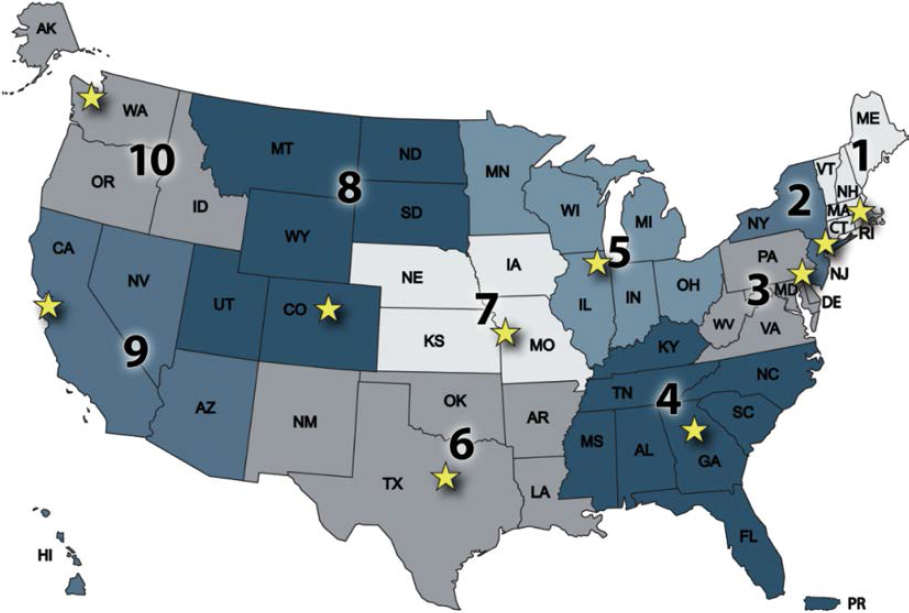
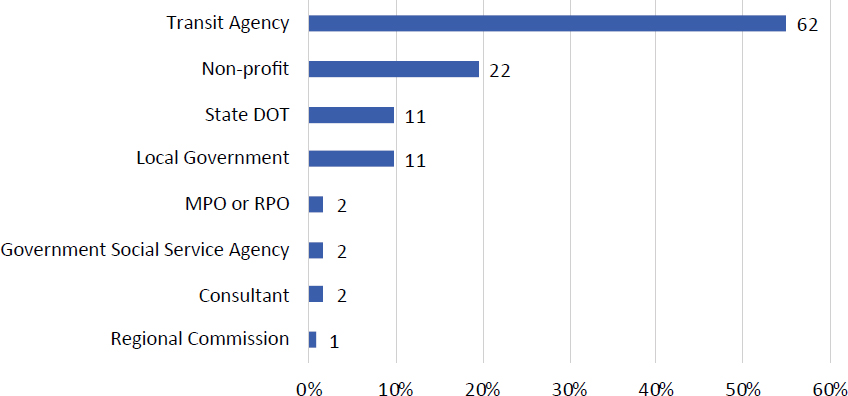
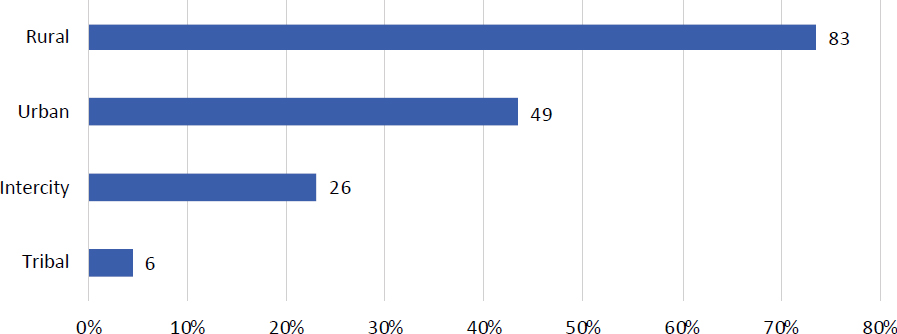
of operating and capital expenditures data from the NTD. Nearly 40 percent of questionnaire respondents indicated that their organization operated on an annual budget of less than $1.5 million prior to the pandemic, as shown in Figure 7. Of organizations represented in the questionnaire responses, 28 percent reported pre-COVID-19 budgets of $1.5 million to $4.99 million, while 34 percent reported pre-COVID-19 budgets of $5 million or more.
Among respondents who indicated that their organization serves only urban areas, 60 percent had annual budgets of $5 million or greater, compared to 10 percent of organizations in the sample that serve only rural areas. Nearly 30 percent of respondents from organizations that serve only rural areas operated on a budget of less than $450,000 pre-COVID-19. This highlights the significant difference across urban and rural contexts in terms of agency size and resources (not shown on Figure 7).
3.3 COVID-19 Adaptation Strategies
Questionnaire respondents were prompted to report on the nontraditional transit initiatives, if any, that their organization implemented to serve their communities in response to the COVID-19 pandemic. Respondents had the option to choose one or more categories of initiatives

or to write in a different response. The team used categories for nontraditional transit initiatives aligned with findings from the literature review, as previously defined in Section 2.2.
As shown in Figure 8, the top three types of initiatives that questionnaire respondents’ organizations implemented during the pandemic were: providing access to vaccination sites (70 percent); providing transportation to COVID-19 testing sites (61 percent); and providing access to food or supplies to members of the community (60 percent). Thirteen questionnaire respondents indicated that their organization did not participate in a nontraditional transit initiative in response to the COVID-19 pandemic.
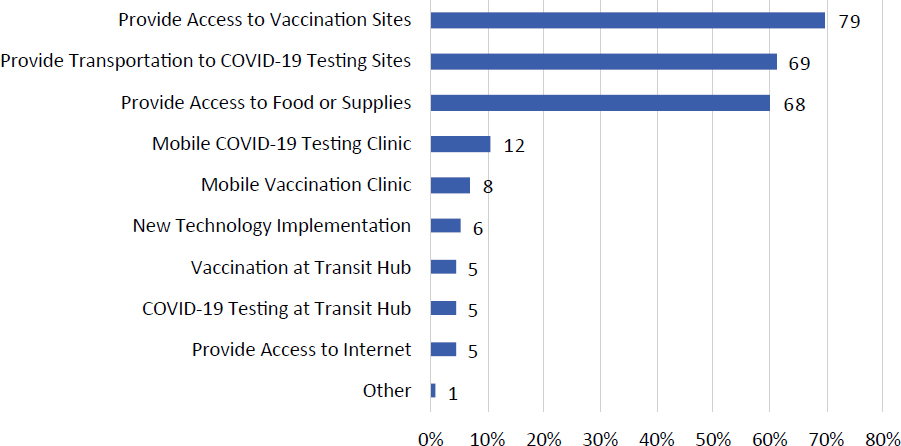
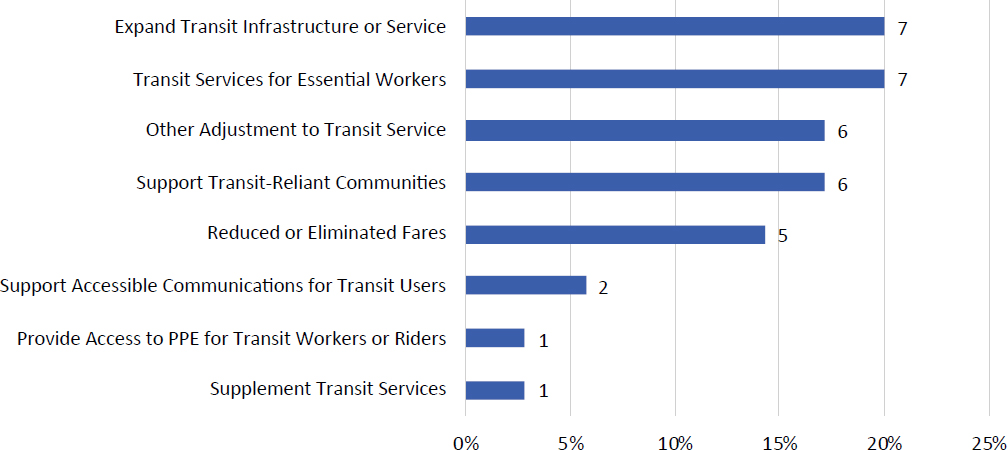
Several respondents wrote in responses to this question, most of which the team decided fit appropriately under one of the established categories. One write-in response, represented by “other” in Figure 8, was not recategorized and represents an initiative in which the transit hub hosted organizations, such as census volunteers, who would normally go door to door in the community.
The questionnaire also asked respondents to report on whether their organization implemented any new or specially designed transit services in response to the COVID-19 pandemic. The question specified that these types of services may have been used to meet the transit needs of essential workers, transit-reliant communities, or meet other equity needs. This question was presented as optional and open response. The team then categorized the open responses using the categories previously described in Section 2.4.
Of the 113 respondents, 76 answered this question, and of these, 35 indicated that their organization implemented such an initiative. As shown in Figure 9, initiatives to expand transit infrastructure or service, as well as initiatives to meet the transit needs of essential workers, represent 20 percent each of the services described in responses to this question. Of agencies that expanded their transit service, several expanded fixed route service to serve rural or remote communities, some of which have no medical facilities or grocery stores. Several organizations adjusted their transit service in other ways, including multiple agencies that either expanded eligibility for their demand response service or used demand response service to fill gaps left by a reduction in fixed route service.
3.4 Partnerships and Funding Sources
3.4.1 Partnerships
Questionnaire respondents were asked to identify the types of organization(s) with which they partnered to carry out the COVID-19 adaptation strategies summarized in the previous section. Figure 10 shows that 85 percent of respondents reported their organization worked with at least one partner, including partnerships with local or state government, nonprofit organizations, educational institutions, medical facilities, and the private sector.
Of the total questionnaire respondents, 53 percent reported that their organization partnered with city, county, and/or municipal government. These organizations likely also represent common

partners outside of pandemic times. State health and human services departments were common partners as well, with 31 percent of respondents reporting such a partnership. Food banks and other nonprofits were identified as partners for a combined 55 percent of respondents. Questionnaire respondents had the option to write in partnership types, categorized as “other” in Figure 10. These partnerships include senior services organizations, federal agencies, and tribal governments.
3.4.2 Funding Sources
To implement the diverse initiatives in response to COVID-19, respondents leveraged a variety of funding sources. Nearly 80 percent of respondents reported the use of federal transportation funding to implement a nontraditional transit or new transit initiative to respond to COVID-19, as shown in Figure 11. State and local funds were commonly used as well, with 55 percent and 48 percent of respondents reporting leveraging these sources, respectively. While less commonly used, several respondents reported the use of funding from nongovernmental organizations (14 percent) and the private sector (8 percent).
3.4.3 COVID-19 Relief Funding Sources
Respondents were prompted to report on their use of federal COVID-19 relief funding for the implementation of nontraditional transit or new transit initiatives. Eighty-six respondents answered this question, of which 78 reported the use of at least one of the three federal

COVID-19 relief funding packages with allocations for transit. Of respondents who reported on the use of COVID-19 relief funding, 90 percent indicated that their initiative(s) utilized funds from the CARES Act, as shown in Figure 12. Fewer respondents used funding from CRRSAA or ARPA, with 30 percent and 19 percent using these funds, respectively. Nine percent of respondents reported that their initiatives did not use COVID-19 relief funding or that they were unsure.
Forty-eight respondents reported that the only federal COVID-19 relief funding used for their initiative(s) was the CARES Act. Of respondents who reported using ARPA funds, 12 used these funds in addition to CARES and CRRSAA funds, 3 used these funds only in addition to CARES funds, and 1 reported only using relief funding from ARPA. Twenty-six respondents indicated that they used CRRSAA funds in addition to CARES funds; no respondents reported CRRSAA as the only source of COVID-19 relief funding.
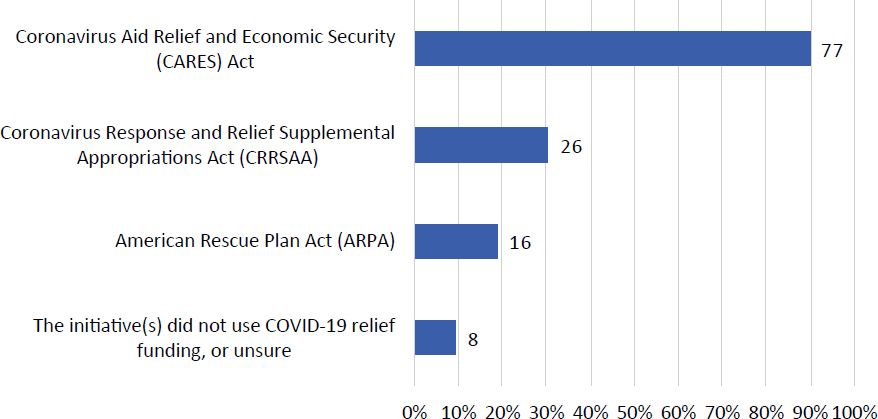
When analyzing responses by area type (i.e., rural, urban, intercity, and tribal), the distribution of COVID-19 relief funding sources used was similar for each area type as the distribution for the total of responses.
3.5 Lessons Learned and Equity Considerations
Questionnaire respondents were asked a series of optional, open-response questions related to challenges they faced during initiative implementation, lessons learned, and how an initiative may have addressed equity goals. About 60 respondents submitted an answer describing the challenges they faced in implementing their initiative(s), while 55 submitted a response describing lessons they learned, success strategies for implementation, and how their initiative addressed equity goals.
3.5.1 Implementation Challenges
Respondents described a variety of challenges they came across during the implementation process for their initiative(s). The most common challenge that respondents described was driver or staff shortages, which affected both nontraditional transit initiatives and new transit services in response to COVID-19. Communications or other coordination-related issues, whether internal, with agency partners, or with the public, were commonly cited issues. Respondents who faced difficulties in working with partners described inconsistent communication or the failure to pass along important information, which was compounded by greater numbers and types of partnering agencies. Regarding communications with the public, several respondents described how challenging it was to effectively inform their communities on their initiative(s); to inform the public of changes to regular service; or to gain the public’s trust, specifically with vaccine-related initiatives.
Several respondents discussed difficulty in using or accessing COVID-19 relief funding as a challenge that their organization faced, particularly if they were a subrecipient of federal funds through another agency. One respondent noted that they did not know how exactly funding could be used. Other respondents described challenges, including safety concerns for drivers or passengers, unclear guidance on COVID-19 precautions, or difficulty leveraging assets with already limited resources (i.e., using transit vehicles for delivery purposes for which they were not designed). A few respondents reported that they faced few challenges in the implementation of their initiative(s), citing past experience with emergency response situations like wildfires or previously strong connections with partner agencies.
3.5.2 Lessons Learned and Success Strategies
In reflecting on lessons learned or strategies that proved successful, respondents shared insights that followed recurring themes. Multiple respondents discussed how early, organized planning and coordination efforts proved successful for their initiative(s) or would have improved the initiative’s success. Many respondents noted that having strong connections with partner agencies prior to the pandemic was crucial for the successful implementation of their initiative(s). For some, this was a lesson they learned through the process and shared that they now have strong partnerships with a variety of community partners or, in one case, up-to-date contact information for potential partnering agencies. Multiple respondents remarked on the importance of clear communication, whether it be internal, with agency partners, or with the public. Some
respondents from agencies that distribute federal funding to subrecipients described prioritizing clear communication of guidelines, procedures, policies, and other vital information with their subrecipients. The implementation of nontraditional transit initiatives also led to greater recognition of transit’s role in emergency response situations in many communities.
3.5.3 Advancing Equity
In responses to the questionnaire’s open-ended questions, many respondents described how the initiatives their organizations implemented addressed equity goals. One of the primary equity themes present in responses was the goal of improving access to services and transit to limited-mobility populations, such as older adults and individuals with disabilities. Many initiatives prioritized the delivery of food or supplies, access to COVID-19 testing and vaccinations, and improved direct communication to meet these or other needs for limited-mobility populations. Similarly, many initiatives prioritized serving low-income populations, those located in remote communities, veterans, and other populations that may be transit dependent. Some nontraditional transit initiatives, such as providing access to food or supplies and providing access to COVID-19 testing and vaccinations, targeted low-income and remote communities, while some new transit service initiatives reduced or eliminated fares and expanded service areas to improve affordability and accessibility. Several respondents noted that their organizations have become more attentive to unmet needs in their communities so that they can better address equity goals in the future.









